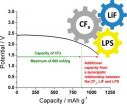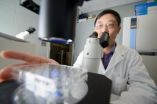(Press-News.org) Culminating an 8 year search, scientists at the RIKEN-MIT Center for Neural Circuit Genetics captured an elusive brain signal underlying memory transfer and, in doing so, pinpointed the first neural circuit for "oops" ? the precise moment when one becomes consciously aware of a self-made mistake and takes corrective action.
The findings, published in Cell, verified a 20 year old hypothesis on how brain areas communicate. In recent years, researchers have been pursuing a class of ephemeral brain signals called gamma oscillations, millisecond scale bursts of synchronized wave-like electrical activity that pass through brain tissue like ripples on a pond. In 1993, German scientist Wolf Singer proposed that gamma waves enable binding of memory associations. For example, in a process called working memory, animals store and recall short-term memory associations when exploring the environment.
In 2006, the MIT team under the direction of Nobel Laureate Susumu Tonegawa began a study to understand working memory in mice. They trained animals to navigate a T maze and turn left or right at a junction for an associated food reward. They found that working memory required communication between two brain areas, the hippocampus and entorhinal cortex, but how mice knew the correct direction and the neural signal for memory transfer of this event remained unclear.
The study's lead author Jun Yamamoto noticed that mice sometimes made mistakes, turning in the wrong direction then pausing, and turning around to go in the correct direction, trials he termed "oops" in his lab notebook. Intrigued, he recorded neural activity in the circuit and observed a burst of gamma waves just before the "oops" moment. He also saw gamma waves when mice chose the correct direction, but not when they failed to choose the correct direction or did not correct their mistakes.
The critical experiment was to block gamma oscillations and prevent mice from making correct decisions. To do this, the researchers created a transgenic mouse with a light-activated protein called archaerhodopsin (ArchT) in the hippocampus. Using an optic fiber implanted in the brain, light was flashed into the hippocampal-entorhinal circuit, shutting off gamma activity. In accord, the mice could no longer accurately choose the right direction and the number of "oops" events decreased.
The findings provide strong evidence of a role for gamma oscillations in cognition, and raise the prospect of their involvement in other behaviors requiring retrieval and evaluation of working memory. This may open the door to a class of behaviors called metacognition, or "thinking about thinking", the self-monitoring of one's actions. Regarding the appearance of gamma oscillations in the "oops" cases, Dr. Tonegawa stated "our data suggest that animals consciously monitor whether their behavioral choices are correct and use memory recall to improve their outcomes"
INFORMATION: END
Oops! Researchers find neural signature for mistake correction
2014-04-24
ELSE PRESS RELEASES FROM THIS DATE:
Large-scale identification and analysis of suppressive drug interactions
2014-04-24
TORONTO – Baker's yeast is giving scientists a better understanding of drug interactions, which are a major cause of hospitalization and illness world-wide.
When two or more medications are taken at the same time, one can suppress or enhance the effectiveness of the other. Similarly, one drug may magnify the toxicity of another. These types of interactions are a major cause of illness and hospitalization. However, there are severe practical limits on the practical scope of drug studies in humans. Limits come in part from ethics and in part from the staggering expense. ...
Skin layer grown from human stem cells could replace animals in drug and cosmetics testing
2014-04-24
An international team led by King's College London and the San Francisco Veteran Affairs Medical Center (SFVAMC) has developed the first lab-grown epidermis – the outermost skin layer - with a functional permeability barrier akin to real skin. The new epidermis, grown from human pluripotent stem cells, offers a cost-effective alternative lab model for testing drugs and cosmetics, and could also help to develop new therapies for rare and common skin disorders.
The epidermis, the outermost layer of human skin, forms a protective interface between the body and its external ...
Scripps Research Institute scientists find new point of attack on HIV for vaccine development
2014-04-24
LA JOLLA, CA— April 24, 2014 —A team led by scientists at The Scripps Research Institute (TSRI) working with the International AIDS Vaccine Initiative (IAVI) has discovered a new vulnerable site on the HIV virus. The newly identified site can be attacked by human antibodies in a way that neutralizes the infectivity of a wide variety of HIV strains.
"HIV has very few known sites of vulnerability, but in this work we've described a new one, and we expect it will be useful in developing a vaccine," said Dennis R. Burton, professor in TSRI's Department of Immunology and Microbial ...
Three-banded panther worm debuts as a new model in the study of regeneration
2014-04-24
CAMBRIDGE, Mass. (April 24, 2014) – Closely resembling plump grains of wild rice set in motion, the three-banded panther worms swimming in disposable containers in Whitehead Institute Member Peter Reddien's lab hardly seem like the next big thing in regeneration. And yet, these little-studied organisms possess the ability to regenerate any part of their bodies and are amenable to molecular studies in the lab, making them a valuable addition to a field keen on understanding how mechanisms controlling regeneration have evolved over millennia and how they might be activated ...
Engineered E. coli produces high levels of D-ribose as described in Industrial Biotechnology journal
2014-04-24
New Rochelle, NY, April 24, 2014—D-ribose is a commercially important sugar used as a sweetener, a nutritional supplement, and as a starting compound for synthesizing riboflavin and several antiviral drugs. Genetic engineering of Escherichia coli to increase the bacteria's ability to produce D-ribose is a critical step toward achieving more efficient industrial-scale production of this valuable chemical, as described in an article in Industrial Biotechnology, a peer-reviewed journal from Mary Ann Liebert, Inc., publishers. The article is available on the Industrial Biotechnology ...
Oxygen diminishes the heart's ability to regenerate, researchers discover
2014-04-24
DALLAS – April 24, 2014 – Scientific research at UT Southwestern Medical Center previously discovered that the newborn animal heart can heal itself completely, whereas the adult heart lacks this ability. New research by the same team today has revealed why the heart loses its incredible regenerative capability in adulthood, and the answer is quite simple – oxygen.
Yes, oxygen. It is well-known that a major function of the heart is to circulate oxygen-rich blood throughout the body. But at the same time, oxygen is a highly reactive, nonmetallic element and oxidizing agent ...
New study helps to explain why breast cancer often spreads to the lung
2014-04-24
New research led by Alison Allan, PhD, a scientist at Western University and the Lawson Health Research Institute, shows why breast cancer often spreads or metastasizes to the lung.
Breast cancer is the number one diagnosed cancer and the number two cause of cancer-related deaths among women in North America. If detected early, traditional chemotherapy and radiation have a high success rate, but once the disease spreads beyond the breast, many conventional treatments fail. In particular, the lung is one of the most common and deadly sites of breast cancer metastasis ...
Parents of severely ill children see benefits as caregivers, says study
2014-04-24
Benefits often coexist with the negative and stressful outcomes for parents who have a child born with or later diagnosed with a life-limiting illness, says a recent study led by a researcher at the University of Waterloo.
While the challenges are numerous and life-changing and stress levels high, the vast majority of parents who participated in the Waterloo-led research reported positive outcomes as well, a phenomenon known as posttraumatic growth. The findings appear in the most recent issue of the American Journal of Orthopsychiatry.
"What is pivotal is the meaning ...
'Double-duty' electrolyte enables new chemistry for longer-lived batteries
2014-04-24
OAK RIDGE, Tenn., April 24, 2014 — Researchers at the Department of Energy's Oak Ridge National Laboratory have developed a new and unconventional battery chemistry aimed at producing batteries that last longer than previously thought possible.
In a study published in the Journal of the American Chemical Society, ORNL researchers challenged a long-held assumption that a battery's three main components -- the positive cathode, negative anode and ion-conducting electrolyte -- can play only one role in the device.
The electrolyte in the team's new battery design has ...
Cell resiliency surprises scientists
2014-04-24
EAST LANSING, Mich. --- New research shows that cells are more resilient in taking care of their DNA than scientists originally thought. Even when missing critical components, cells can adapt and make copies of their DNA in an alternative way.
In a study published in this week's Cell Reports, a team of researchers at Michigan State University showed that cells can grow normally without a crucial component needed to duplicate their DNA.
"Our genetic information is stored in DNA, which has to be continuously monitored for damage and copied for growth," said Kefei Yu, ...





